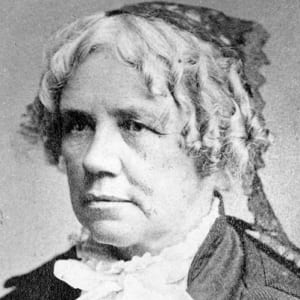Rising of the Stars
Maria Mitchell
“We see most when we are most determined to see.”—Maria Mitchell
Since the nineteenth century, children have recited the nursery rhyme “Twinkle, twinkle, little star, how I wonder what you are . . .” In Nantucket, Maria Mitchell did more than wonder about the stars. To partake of the astronomer’s “sweeping the sky,” journey to the Maria Mitchell House.
Comets have long captured the popular imagination. In William Shakespeare’s play The Tragedy of Julius Caesar, on the evening of her husband’s assassination, Calpurnia observed, “When beggars die, there are no comets seen / The heavens themselves blaze forth the death of princes.”
Maria (pronounced Ma-RYE-ah) was born in 1818, in Nantucket, the island Herman Melville, author of Moby Dick, described as an “elbow of sand.” The Mitchells lived on Prison Lane, so named after the jail located up the street. Currently, the location bears the address 1 Vestal Street. Vestal is an allusion to the Roman mythological Vesta, whose father swallowed her—along with his five other children—in fear they would partake of patricide. In contrast, Maria and her father, William, shared an unbreakable bond. Her mother, Lydia, a member of the Coleman family, was a distant relative of Abiah Folger, Benjamin Franklin’s mother. Prior to marriage, Lydia was a librarian; however, with ten children and a husband who had his head in the clouds (or rather the sky), she no longer had leisure to read.
The Mitchells were members of the Nantucket Society of Friends though William occasionally sidestepped dogma. He enjoyed color and chose books with red covers, painted his telescope’s stand a bright red, and hung a glass ball from the ceiling that created prisms on the walls. When the Mitchells moved, they purchased a piano, although his congregation considered the instrument a frivolity.
Aware Maria was a prodigy, William provided her with a room of her own at the bottom of the garret stairs. The space was the size of a closet but held shelves (one of which served as a desktop), a chair, and a whale-oil lamp. On the door, she hung a sign: MISS MITCHELL IS BUSY. DO NOT KNOCK. Father and daughter spent their nights “sweeping the sky.” As they gazed into the heavens, William told his daughter, “Thee must wonder.” 
While the Mitchell sisters sought husbands, the only rings Maria was interested in were the ones around Saturn. Rather than socialize, Maria would put on her “regimentals”—her hood, coat, and mittens, and climbed the stairs to the rooftop observatory. Reluctance to marry may have stemmed from her mother, worn out from ten pregnancies (Eliza died at age three). Another theory: most men wanted wives in the kitchen, the nursery, the bedroom rather than on the roof.
At age seventeen, Maria founded a private school that caused a tempest in a Nantucket teapot as it was racially integrated. After a year, the school closed its doors when Maria left to become the first librarian at the Nantucket Atheneum, so named after Athena, the goddess of wisdom. Access to the library’s thirty-two-hundred books was a substitute for college since the only university open to women was Ohio’s Oberlin College. In the upstairs Lyceum room, the famous delivered lectures: philosopher Ralph Waldo Emerson, author Henry David Thoreau, artist John James Audubon, abolitionist Lucy Stone, and ex-slave Frederick Douglass. Her position, which Maria held for twenty years, allowed her to meet Herman Melville and Sojourner Truth. Partially due to the radical thinkers, Maria questioned her Quaker faith. Ultimately, she cut ties with her church when it excommunicated her brother Andrew for marrying a nonmember.
In 1836 William accepted a position at the Pacific Bank, situated in a large brick building, that allowed his family to reside on the top floor—far more spacious than their home on Vestal Street. William set up a small rooftop observatory.
Eleven years later, as the twenty-nine-year-old Maria peered through her telescope into the Nantucket night, she spied a comet just above Polaris. William exhorted, “Thee must tell the world,” but Maria was too unassuming to announce she had discovered what had eluded distinguished European astronomers. William contacted members of the Harvard Observatory, but by the time his letter arrived, Father de Vico at the Vatican Observatory in Rome had received astronomy’s coveted award. Eventually, official recognition fell on the woman from Nantucket. William and Maria called her great find, “the comet of the tenth month”; the scientific community dubbed it Comet 1847 VI; colloquially, it is Miss Mitchell’s Comet. The event gained Maria a foothold amongst the stars, as well as earthly honors. King Frederick VI of Denmark (whose predecessor had, in 1831, promised a gold medal to anyone who discovered a new comet) bestowed the honor that made her the first woman and the first American to receive the award. She received recognition at the first women’s rights conference in Seneca Falls and garnered international headlines. In 1844 Maria became the first female member of the American Association for the Advancement of Science.
As a child Maria had watched men sail away on their whaling ships, and she longed to travel, a dream realized in 1857. The first stage of her journey was in New Orleans where the slave markets brought home the horror of human bondage. In New York, she boarded the Arabia; in London, she paid tribute at Sir Isaac Newton’s grave in Westminster Abby. In the company of author Nathaniel Hawthorne and his wife, Sophia, she departed for Rome. Her aspiration was to visit the Vatican’s Observatory to end its edict that precluded women. Of her exclusion she wrote, “My woman’s robe must not brush the seats of learning.” Eventually, the Vatican allowed her entry, making Maria the first woman to set foot in the male domain. She wanted to remain in the observatory till dark to view the heavens through its telescope, but Father Angelo Secchi explained her visit could not extend beyond daylight.
The lives of a Poughkeepsie brewer and a Nantucket astronomer merged when Matthew Vassar founded Vassar College for women—though it excluded black women. Vassar hired Maria Mitchell as its Professor of Mathematics and Director of the Observatory. Her students absorbed scientific knowledge along with exposure to the Suffrage Movement. Through her intercession, Julia Ward Howe, Louisa May Alcott, Lucy Stone, and Elizabeth Cady Stanton visited Vassar. Not surprisingly, Maria ruffled faculty feathers: she refused to give grades and argued against male professors’ higher salaries.
The incomparable Maria Mitchell passed away in 1889. Her grave is at Prospect Hill Cemetery in Nantucket, near her parents, in the shadow of the Nantucket Maria Mitchell Association’s Loines Observatory.
The Mitchell House
The museum is a 1790s Quaker-style structure that, as a guide explains, has “never been electrified, plumbed, or chopped up to accommodate modern conveniences. It remains exactly as it was when the family lived here in the early 1800s.”
Visitors step into the past when they tour the two-story house covered with unpainted shingles, weathered gray by rain, fog, and age. An interesting exhibit is Maria’s Thumbelina-size study. The parlor holds William’s telescope, with which his daughter catapulted into history. Hanging on the wall is the 1848 invitation to the American Academy of Arts and Sciences. The organization’s secretary, Asa Gray, opposed to a woman’s inclusion, crossed out the salutation Sir. He also altered the word “Fellow” to “Honorary Member-” a change that reflected his disapproval of a female’s appointment. For verisimilitude, the kitchen appears as if someone were preparing a meal. All the rooms, except the wood-grained kitchen and two that are wallpapered, retain their original white-and-gray color ; furnishings are authentic to the era. Under the ledge of one of its desks, Maria’s mother, Lydia, pasted a newspaper article about her husband’s achievements; Quaker modesty frowned on boasting. Personal effects include: Lydia’s childhood sampler; Maria’s mother-of-pearl opera glasses, sewing box, a teacup souvenir from Europe, beer mugs (for medicinal purposes) and her Dollond telescope. The Maria Mitchell Association has 879 objects in its collection, in addition to 321 books from Maria’s personal library. There is a “Peep at the Moon” frieze—a 1928 stencil created by Maria’s cousin. The antique grandfather clock, a wedding present to William and Lydia, still ticks the passing of time. The roof walk recalls when father and daughter swept the skies.


